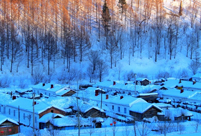 Fighters of Lanzhou MAC in confrontation training
Fighters of Lanzhou MAC in confrontation training
 3D printing to trigger third industrial revolution
3D printing to trigger third industrial revolution
 Top 10 brands that win rich women's hearts
Top 10 brands that win rich women's hearts
 Deng Xiaoping: 'I have a clear conscience all my life'
Deng Xiaoping: 'I have a clear conscience all my life'
 Xi Jinping: 'The people are our strength'
Xi Jinping: 'The people are our strength'
 Amazing cliff diving in cold winter
Amazing cliff diving in cold winter
 Enjoy Sochi 2014 in slow motion
Enjoy Sochi 2014 in slow motion
 University student sentenced to death for poisoning roommate
University student sentenced to death for poisoning roommate
 Chinese lunar New Year celebrated in San Francisco
Chinese lunar New Year celebrated in San Francisco
LHASA, March 6 -- An extension of the Qinghai-Tibet railway,the world's highest, will reach the residence of the Panchen Lama at Xigaze, Tibet, the contractors confirmed on Thursday.
The Lhasa-Xigaze railway, will be open before October.
With an overall length of 253 km, trains will run at a maximum speed of 120 km per hour, representing a run time of about two hours from the regional capital to Tibet's second largest city.
All subgrade earthworks, bridges, culverts, tunnels and over 93 percent of the track are complete. Four major briges, three across the Yarlung Zangbo River and one across its branch the Nyangchu, have all been finished.
"The journey used to take least four or five hours on mountain roads. We are looking forward to worshipping Buddha by train," said Tob Chung, 38, a lama at Tashihunpo Monastery, the seat of the Panchen Lamas.
"It is the common dream of all the Tibetan faithful to worship the Buddha in Lhasa and Xigaze. The railway will make the journey safer and easier," said the lama.
Both cities are sacred for Tibetan buddhists with important religious centers such as the Potala Palace, Tashihunpo Monastery and Jokhang Monastery.
"Besides saving time, the railway will be much more safe. The current road is frequently troubled by seasonal natural disasters," said Shang Hongwei, a construction foreman from China Railway's 12th Bureau.
Local residents and tourists will have a smooth trip by rail, unimpeded by landslides in summer and ice in the winter, said Shang.
Also famous as "Tibet's granary," Xigaze has until now relied on road transportation as its one connection with the outside world. The city attracts thousands of pilgrims and visitors each year. In recent years, Tashihunpo Monastery has received over 200,000 visitors from home and abroad annually.
When the new line opens, Tibetan Buddhism and culture will surely attract more people to visit, said Dawa Qungda of Tashihunpo.
Dawa Qungda expects the railway to help economic development and, in turn, to help residents along the way become more prosperous.
The plateau railway is a particularly problematic construction with difficulties including an oxygen-poor environment, a delicate ecosystem, wildlife migrations, and many complex environmental issues.
The Qinghai-Tibet Railway began service in July 2006 and has positively impacted on Tibet's tourism, hospitality and manufacturing sectors.
The plateau railway which covers 1,956 km from Xining in Qinghai Province to Lhasa carried 11.7 million passengers and 57.8 million tonnes of cargo in 2013.
Railway builders faced harsh tests of frozen earth, high altitude and a fragile environment, said Zhu Jintang, chief engineer of one section. "Along the Lhasa-Xigaze line, we overcame new challenges such as the long spans and deep water bridges, as well as a high geothermal tunnel," he added.
"To minimize disturbance to wildlife, we set up bridges across wetlands and a nature reserve for black cranes. We also used vegetation slope protection, sand and sound barriers," said Zhu.
Lamas at Tashihunpo plan to make a pilgrimage by train to Tibetan areas in Qinghai, Gansu and other provinces, said Tob Chung.
"My parents have never stepped out of their remote village in Sa'gya County. I can hardly wait to take them on a pilgrimage to Lhasa and to see the outside world," he said.
 Chaihe village, pure and peaceful fairyland in snow
Chaihe village, pure and peaceful fairyland in snow Belgians warmly welcome arrival of China's giant pandas
Belgians warmly welcome arrival of China's giant pandas Female marines receive tactical training in NW China
Female marines receive tactical training in NW China Blood memory: Nanjing Massacre in 1937
Blood memory: Nanjing Massacre in 1937 Top 10 pure beauties in showbiz
Top 10 pure beauties in showbiz British WWII veteran: I can't forgive Japan
British WWII veteran: I can't forgive Japan Tongban's dream of prosperity
Tongban's dream of prosperity Chinese frigate Yancheng holds drills in Mediterranean Sea
Chinese frigate Yancheng holds drills in Mediterranean Sea A visit to comfort woman's home in South Korea
A visit to comfort woman's home in South Korea Fairyland? Qingdao in sea of clouds
Fairyland? Qingdao in sea of clouds Top 10 most handsome faces in Asia in 2013
Top 10 most handsome faces in Asia in 2013 Female celebs with beautiful long legs
Female celebs with beautiful long legs Cat 'guardians' in Forbidden City
Cat 'guardians' in Forbidden City Large numbers of ancient coins excavated in Inner Mongolia
Large numbers of ancient coins excavated in Inner Mongolia Leisurely life beneath Zhonggulou, where time travels slower
Leisurely life beneath Zhonggulou, where time travels slowerDay|Week|Month